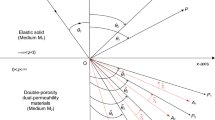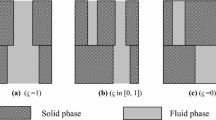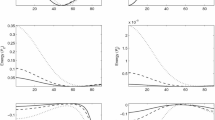Abstract
We obtain the reflection and transmission coefficients for inhomogeneous plane waves incident on a flat interface separating two double-porosity media described by the Biot–Rayleigh model, which takes into account the effect of local fluid flow (LFF). Three longitudinal and one transverse waves are reflected and transmitted, represented by potential functions specified by the propagation and attenuation directions. The continuity of the energy at the interface for sealed and open-boundary conditions yields a system of equations for the coefficients, and the expressions of the energy ratios for the reflected and refracted waves are derived in closed form. Numerical examples showing the magnitude, phase and energy ratio as a function of frequency and incidence angle are carried out to investigate the influence of the inhomogeneity angle, boundary condition, type of incidence wave and LFF effect. The results confirm that the LFF affects the reflection and transmission behaviors for the incident P1 and SV waves, irrespective of whether the interface is open or sealed. The effect causes interference fluxes between different waves, a consequence of energy conservation at the interface. We also perform full-waveform simulations to validate the results.



















Similar content being viewed by others
References
Agersborg R, Johansen TA, Jakobsen M (2009) Velocity variations in carbonate rocks due to dual porosity and wave-induced fluid flow. Geophys Prospect 57(1):81–98
Arora A, Tomar SK (2008) The effect of inertial coupling on seismic reflection amplitudes. Geophys Prospect 56(5):643–654
Arora A, Painuly A, Tomar SK (2015) Body waves in composite solid matrix containing two immiscible fluids. Transp Porous Med 108(3):531–554
Ba J, Carcione JM, Nie J (2011) Biot–Rayleigh theory of wave propagation in double-porosity media. J Geophys Res Solid Earth 116:B06202
Berryman JG, Wang HF (2000) Elastic wave propagation and attenuation in a double-porosity dual-permeability medium. Int J Rock Mech Min 37(1–2):63–78
Biot MA (1956) Theory of propagation of elastic waves in a fluid-saturated porous solid. I. Low frequency range. J. Acoust. Soc. Am. 28(2):168–178
Biot MA (1962) Mechanics of deformation and acoustic propagation in porous media. J Appl Phys 33(4):1482–1498
Borcherdt RD (1982) Reflection–refraction of general P-and type-I S-waves in elastic and anelastic solids. Geophys J Int 70(3):621–638
Brajanovski M, Müller TM, Gurevich B (2006) Characteristic frequencies of seismic attenuation due to wave-induced fluid flow in fractured porous media. Geophys J Int 166(2):574–578
Brutsaert W (1964) The propagation of elastic waves in unconsolidated unsaturated granular mediums. J Geophys Res 69(2):243–257
Carcione JM (2014) Wave fields in real media. Theory and numerical simulation of wave propagation in anisotropic, anelastic, porous and electromagnetic media, 3rd edn. Elsevier, Amsterdam
Carcione JM, Picotti S (2006) P-wave seismic attenuation by slow wave diffusion. Effects of inhomogeneous rock properties. Geophysics 71(3):O1–O8
Carcione JM, Seriani G (2001) Wave simulation in frozen porous media. J Comput Phys 170:676–695
Carcione JM, Tinivella U (2000) Bottom-simulating reflectors: seismic velocities and AVO effect. Geophysics 65(1):54–67
Carcione JM, Morency C, Santos JE (2010) Computational poroelasticity: a review. Geophysics 75:A229–A243
Castagna JP, Swan HW, Foster DJ (1998) Framework for AVO gradient and intercept interpretation. Geophysics 63(3):948–956
Cui ZW, Wang KX (2003) Influence of the squirt flow on reflection and refraction of elastic waves at a fluid/fluid-saturated poroelastic solid interface. Int J Eng Sci 41(18):2179–2191
Dai Z, Kuang Z, Zhao S (2006a) Reflection and transmission of elastic waves from the interface of a fluid-saturated porous solid and a double porosity solid. Transp Porous Med 65(2):237–264
Dai Z, Kuang Z, Zhao S (2006b) Reflection and transmission of elastic waves at the interface between an elastic solid and a double porosity medium. Int J Rock Mech Min 6(43):961–971
Denneman AIM, Drijkoningen GG, Smeulders DMJ, Wapenaar K (2002) Reflection and transmission of waves at a fluid/porous-medium interface. Geophysics 67(1):282–291
Deresiewicz H, Rice JT (1962) The effect of boundaries on wave propagation in a liquid-filled porous solid: III. Reflection of plane waves at a free plane boundary (general case). Bull Seismol Soc Am 52(3):595–625
Deresiewicz H, Rice JT (1964) The effect of boundaries on wave propagation in a liquid-filled porous solid-V: transmission across plane interface. Bull Seismol Soc Am 54(1):409–416
Dutta NC, Odé H (1983) Seismic reflections from a gas–water contact. Geophysics 48(2):148–162
Gurevich B, Zyriano VB, Lopatnikov SL (1997) Seismic attenuation in finely layered porous rocks: effects of fluid flow and scattering. Geophysics 62(1):319–324
Gurevich B, Ciz R, Denneman AIM (2004) Simple expressions for normal incidence reflection coefficients from an interface between fluid-saturated porous materials. Geophysics 69(6):1372–1377
Kumar M, Saini R (2012) Reflection and refraction of attenuated waves at boundary of elastic solid and porous solid saturated with two immiscible viscous fluids. Appl Math Mech Engl 33(6):797–816
Kumar M, Sharma MD (2013) Reflection and transmission of attenuated waves at the boundary between two dissimilar poroelastic solids saturated with two immiscible viscous fluids. Geophys Prospect 61(5):1035–1055
Leclaire P, Cohen-Ténoudji F, Aguirre-Puente J (1994) Extension of Biot’s theory of wave propagation to frozen porous media. J Acoust Soc Am 96(6):3753–3768
Liu L, Cao S, Wang L (2011) Poroelastic analysis of frequency-dependent amplitude-versus-offset variations. Geophysics 76(3):C31–C40
Lo WC, Sposito G, Majer E (2005) Wave propagation through elastic porous media containing two immiscible fluids. Water Resour Res 41(2):W02025
Müller TM, Gurevich B, Lebedev M (2010) Seismic wave attenuation and dispersion resulting from wave-induced flow in porous rocks—a review. Geophysics 75(5):75A147–75A164
Painuly A, Arora A (2018) Reflection and transmission of inhomogeneous waves in a composite porous solid saturated by two immiscible fluids. Geophys Prospect 66(1):182–196
Pride SR, Berryman JG (2003a) Linear dynamics of double porosity dual-permeability materials. I. Governing equations and acoustic attenuation. Phys Rev E 68(3):036603
Pride SR, Berryman JG (2003b) Linear dynamics of double porosity dual-permeability materials. II. Fluid transport equations. Phys Rev E 68(3):036604
Pride SR, Berryman JG, Harris JM (2004) Seismic attenuation due to wave-induced flow. J Geophys Res 109:B01201
Rubino JG, Ravazzoli CL, Santos JE (2006) Reflection and transmission of waves in composite porous media: a quantification of energy conversions involving slow waves. J Acoust Soc Am 120(5):2425–2436
Santos JE, Douglas J Jr, Corbero J, Lovera OMA (1990) A model for wave propagation in a porous medium saturated by a two phase fluid. J Acoust Soc Am 87(4):1439–1448
Santos JE, Corbero JM, Ravazzoli CL, Hensley JL (1992) Reflection and transmission coefficients in fluid-saturated porous media. J Acoust Soc Am 91(4):1911–1923
Santos JE, Ravazzoli CL, Carcione JM (2004) A model for wave propagation in a composite solid matrix saturated by a single-phase fluid. J Acoust Soc Am 115(6):2749–2760
Sharma MD (2013) Effect of local fluid flow on reflection of plane elastic waves at the boundary of a double-porosity medium. Adv Water Resour 61:62–73
Sharma MD, Kumar M (2011) Reflection of attenuated waves at the surface of a porous solid saturated with two immiscible viscous fluids. Geophys J Int 184(1):371–384
Shekhar S, Parvez IA (2016) Reflection and refraction of attenuated waves at the interface between cracked poroelastic medium and porous solid saturated with two immiscible fluids. Transp Porous Med 113(2):405–430
Sidler R, Carcione JM, Holliger K (2013) A pseudospectral method for the simulation of 3-D ultrasonic and seismic waves in heterogeneous poroelastic borehole environments. Geophys J Int 196:1134–1151
Tomar SK, Arora A (2006) Reflection and transmission of elastic waves at an elastic/porous solid saturated by two immiscible fluids. Int J Solids Struct 43(7–8):1991–2013
Tuncay K, Corapcioglu MY (1997) Wave propagation in poroelastic media saturated by two fluids. J Appl Mech 64(2):313–320
Wang E, Carcione JM, Ba J (2019) Wave simulation in double-porosity media based on the Biot–Rayleigh theory. Geophysics 84:WA11–WA21
Yeh CL, Lo WC, Jan CD, Yang CC (2010) Reflection and refraction of obliquely incident elastic waves upon the interface between two porous elastic half-spaces saturated by different fluid mixtures. J Hydrol 395(1–2):91–102
Zhao L, Han DH, Yao Q, Zhou R, Yan F (2015) Seismic reflection dispersion due to wave-induced fluid flow in heterogeneous reservoir rocks. Geophysics 80(3):D221–D235
Acknowledgements
We thank the Editor in Chief and anonymous reviewers for their helpful comments. This research is supported by the “National Nature Science Foundation of China (41804095, 41974123),” the “Fundamental Research Funds for the Central Universities (2019B17614),” and the “China Postdoctoral Science Foundation (2017M621618 and 2019T120384).”
Author information
Authors and Affiliations
Corresponding author
Additional information
Publisher's Note
Springer Nature remains neutral with regard to jurisdictional claims in published maps and institutional affiliations.
Appendices
Appendix 1
Let us denote the volume fractions of the two phases by \( \nu_{1} \) and \( \nu_{2} \) (\( \nu_{2} = 1 - \nu_{1} \)), the two local porosities in the host and inclusions by \( \phi_{10} \) and \( \phi_{20} \), the densities of solid grain and fluid by \( \rho_{s} \) and \( \rho_{f} \), the grain bulk and shear moduli by \( K_{s} \) and \( \mu_{s} \), the fluid bulk modulus by \( K_{f} \), the two kinds of permeability by \( \kappa_{1} \) and \( \kappa_{2} \), the fluid viscosity by \( \eta \), the radius of the inclusion by \( R_{0} \), and the three consolidation parameters by \( c_{1} \), \( c_{2} \) and \( c_{s} \).
In uniform porosity case, the two partial porosities are defined by Ba et al. (2011)
where \( \phi \) is the total porosity. The five density parameters in Eq. (1) are defined as
The stiffness parameters are
\( b_{1} \) and \( b_{2} \) are
In the non-uniform porosity case (Wang et al. 2019),
Parameter \( \lambda_{c} \) is
Following Eqs. (55) and (53), the relations among \( Q_{i} \), \( R_{i} \), \( \alpha_{i} \), and \( M_{i} \) are
The density \( \rho \) is
Appendix 2
The elements of matrix G in Eq. (33) are
For the open boundary,
For the sealed boundary,
In the case of an incident P1 wave, irrespective of the boundary being open or sealed, the first four elements in y are
For the open boundary,
For the sealed boundary,
In the case of an incident SV wave, irrespective of the boundary being open or sealed, the elements in y are
The parameters \( D_{i}^{\rm I} \) and \( D_{i}^{\rm II} \) in Eqs. (61), (64), (66), (71), and (72) are given in “Appendix 3”.
Appendix 3
The expressions for \( D_{i}^{\rm I} \left( {i = 1,2, \ldots ,8,9} \right) \) in Eq. (38) in medium \( \varOmega_{ 1} \) are
where
By replacing index I with II in Eqs. (76)–(85), the corresponding formulae for medium \( \varOmega_{ 2} \) can be obtained.
Rights and permissions
About this article
Cite this article
Wang, E., Carcione, J.M., Ba, J. et al. Reflection and Transmission of Plane Elastic Waves at an Interface Between Two Double-Porosity Media: Effect of Local Fluid Flow. Surv Geophys 41, 283–322 (2020). https://doi.org/10.1007/s10712-019-09572-6
Received:
Accepted:
Published:
Issue Date:
DOI: https://doi.org/10.1007/s10712-019-09572-6




